Motivation and Employee Performance in Organizations
VerifiedAdded on 2023/01/19
|15
|4201
|60
AI Summary
This essay explores the importance of motivation in achieving organizational goals and the impact of employee relations on performance. It discusses various theories and findings related to motivation and organizational behavior.
Contribute Materials
Your contribution can guide someone’s learning journey. Share your
documents today.
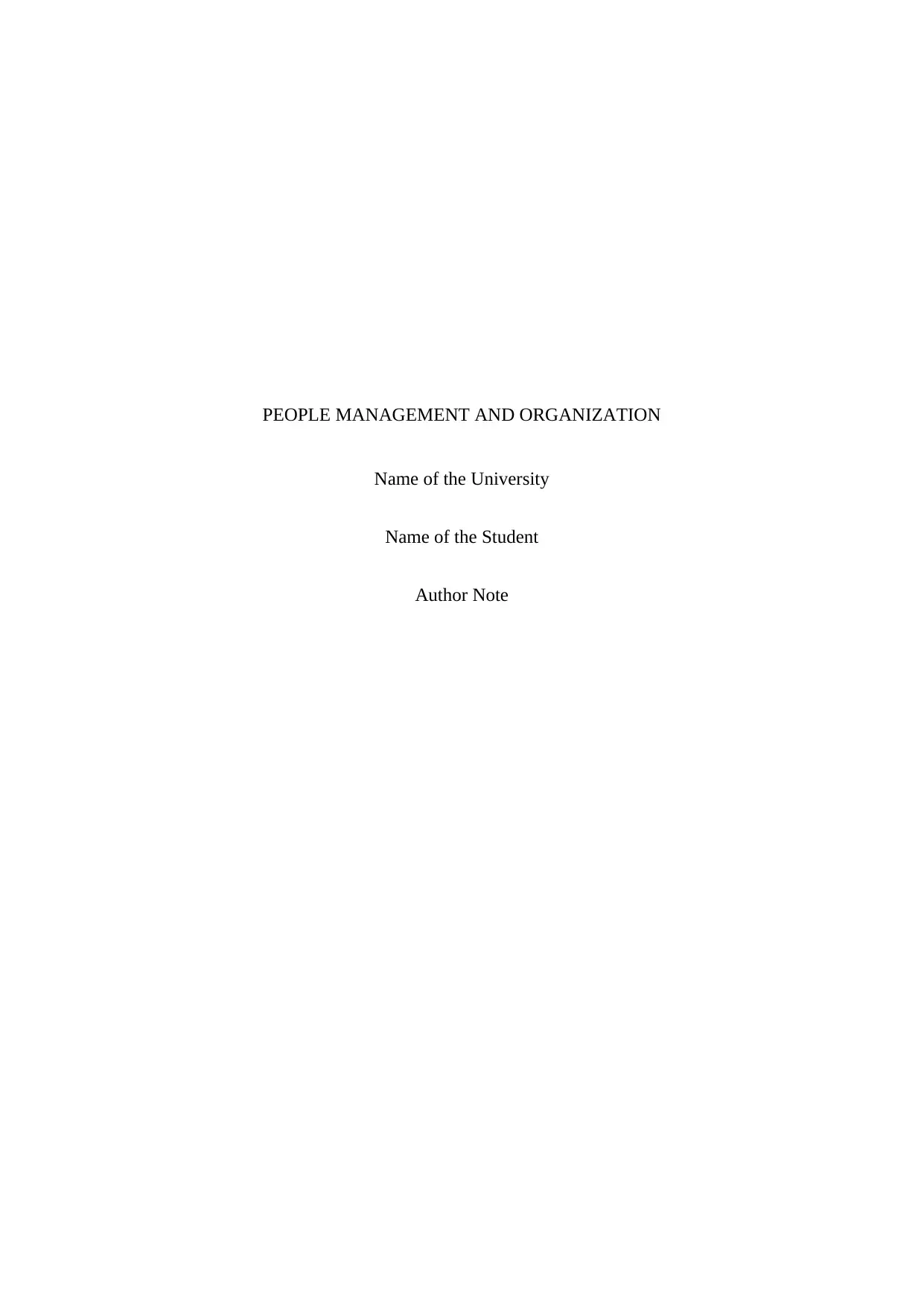
PEOPLE MANAGEMENT AND ORGANIZATION
Name of the University
Name of the Student
Author Note
Name of the University
Name of the Student
Author Note
Secure Best Marks with AI Grader
Need help grading? Try our AI Grader for instant feedback on your assignments.
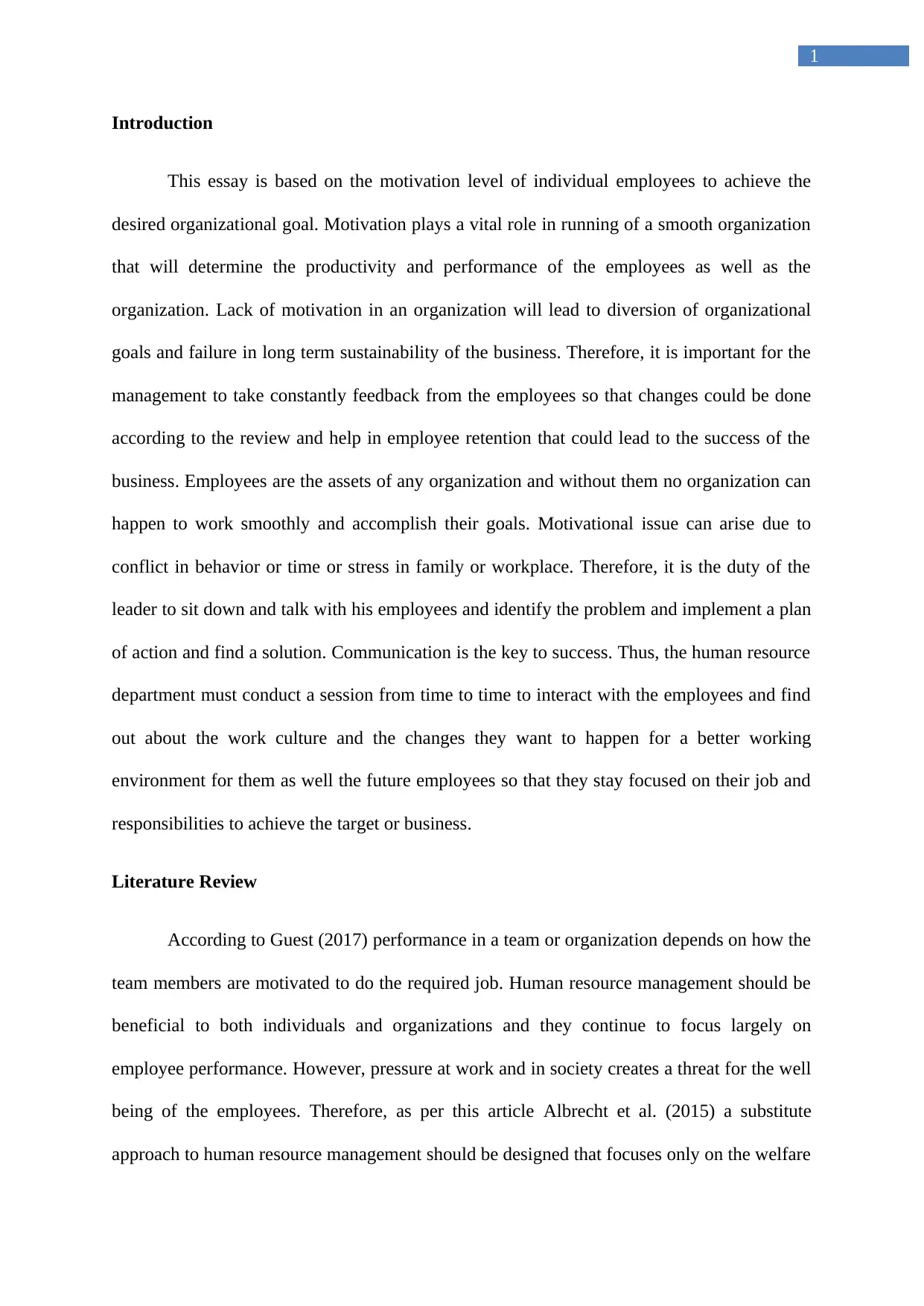
1
Introduction
This essay is based on the motivation level of individual employees to achieve the
desired organizational goal. Motivation plays a vital role in running of a smooth organization
that will determine the productivity and performance of the employees as well as the
organization. Lack of motivation in an organization will lead to diversion of organizational
goals and failure in long term sustainability of the business. Therefore, it is important for the
management to take constantly feedback from the employees so that changes could be done
according to the review and help in employee retention that could lead to the success of the
business. Employees are the assets of any organization and without them no organization can
happen to work smoothly and accomplish their goals. Motivational issue can arise due to
conflict in behavior or time or stress in family or workplace. Therefore, it is the duty of the
leader to sit down and talk with his employees and identify the problem and implement a plan
of action and find a solution. Communication is the key to success. Thus, the human resource
department must conduct a session from time to time to interact with the employees and find
out about the work culture and the changes they want to happen for a better working
environment for them as well the future employees so that they stay focused on their job and
responsibilities to achieve the target or business.
Literature Review
According to Guest (2017) performance in a team or organization depends on how the
team members are motivated to do the required job. Human resource management should be
beneficial to both individuals and organizations and they continue to focus largely on
employee performance. However, pressure at work and in society creates a threat for the well
being of the employees. Therefore, as per this article Albrecht et al. (2015) a substitute
approach to human resource management should be designed that focuses only on the welfare
Introduction
This essay is based on the motivation level of individual employees to achieve the
desired organizational goal. Motivation plays a vital role in running of a smooth organization
that will determine the productivity and performance of the employees as well as the
organization. Lack of motivation in an organization will lead to diversion of organizational
goals and failure in long term sustainability of the business. Therefore, it is important for the
management to take constantly feedback from the employees so that changes could be done
according to the review and help in employee retention that could lead to the success of the
business. Employees are the assets of any organization and without them no organization can
happen to work smoothly and accomplish their goals. Motivational issue can arise due to
conflict in behavior or time or stress in family or workplace. Therefore, it is the duty of the
leader to sit down and talk with his employees and identify the problem and implement a plan
of action and find a solution. Communication is the key to success. Thus, the human resource
department must conduct a session from time to time to interact with the employees and find
out about the work culture and the changes they want to happen for a better working
environment for them as well the future employees so that they stay focused on their job and
responsibilities to achieve the target or business.
Literature Review
According to Guest (2017) performance in a team or organization depends on how the
team members are motivated to do the required job. Human resource management should be
beneficial to both individuals and organizations and they continue to focus largely on
employee performance. However, pressure at work and in society creates a threat for the well
being of the employees. Therefore, as per this article Albrecht et al. (2015) a substitute
approach to human resource management should be designed that focuses only on the welfare
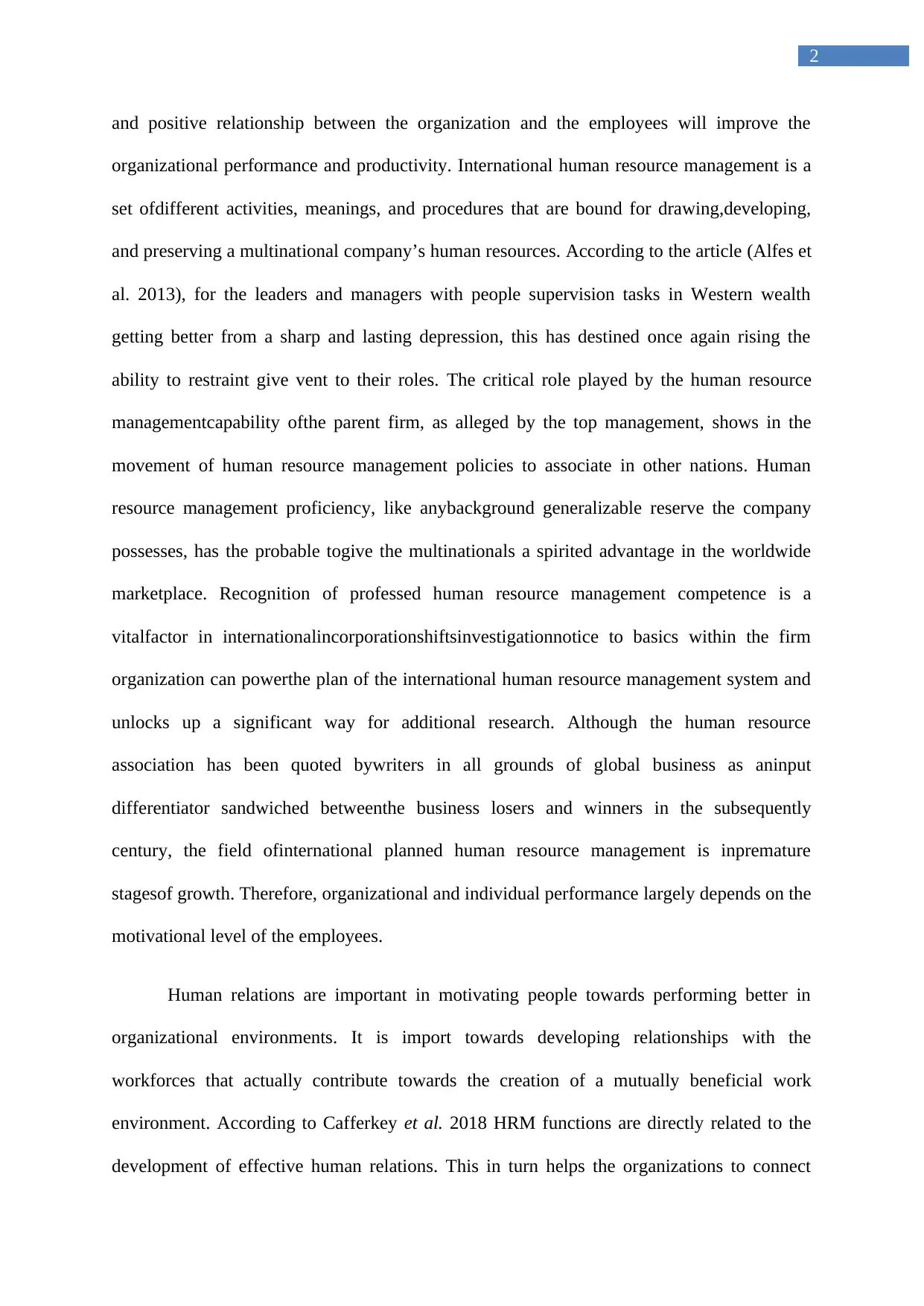
2
and positive relationship between the organization and the employees will improve the
organizational performance and productivity. International human resource management is a
set ofdifferent activities, meanings, and procedures that are bound for drawing,developing,
and preserving a multinational company’s human resources. According to the article (Alfes et
al. 2013), for the leaders and managers with people supervision tasks in Western wealth
getting better from a sharp and lasting depression, this has destined once again rising the
ability to restraint give vent to their roles. The critical role played by the human resource
managementcapability ofthe parent firm, as alleged by the top management, shows in the
movement of human resource management policies to associate in other nations. Human
resource management proficiency, like anybackground generalizable reserve the company
possesses, has the probable togive the multinationals a spirited advantage in the worldwide
marketplace. Recognition of professed human resource management competence is a
vitalfactor in internationalincorporationshiftsinvestigationnotice to basics within the firm
organization can powerthe plan of the international human resource management system and
unlocks up a significant way for additional research. Although the human resource
association has been quoted bywriters in all grounds of global business as aninput
differentiator sandwiched betweenthe business losers and winners in the subsequently
century, the field ofinternational planned human resource management is inpremature
stagesof growth. Therefore, organizational and individual performance largely depends on the
motivational level of the employees.
Human relations are important in motivating people towards performing better in
organizational environments. It is import towards developing relationships with the
workforces that actually contribute towards the creation of a mutually beneficial work
environment. According to Cafferkey et al. 2018 HRM functions are directly related to the
development of effective human relations. This in turn helps the organizations to connect
and positive relationship between the organization and the employees will improve the
organizational performance and productivity. International human resource management is a
set ofdifferent activities, meanings, and procedures that are bound for drawing,developing,
and preserving a multinational company’s human resources. According to the article (Alfes et
al. 2013), for the leaders and managers with people supervision tasks in Western wealth
getting better from a sharp and lasting depression, this has destined once again rising the
ability to restraint give vent to their roles. The critical role played by the human resource
managementcapability ofthe parent firm, as alleged by the top management, shows in the
movement of human resource management policies to associate in other nations. Human
resource management proficiency, like anybackground generalizable reserve the company
possesses, has the probable togive the multinationals a spirited advantage in the worldwide
marketplace. Recognition of professed human resource management competence is a
vitalfactor in internationalincorporationshiftsinvestigationnotice to basics within the firm
organization can powerthe plan of the international human resource management system and
unlocks up a significant way for additional research. Although the human resource
association has been quoted bywriters in all grounds of global business as aninput
differentiator sandwiched betweenthe business losers and winners in the subsequently
century, the field ofinternational planned human resource management is inpremature
stagesof growth. Therefore, organizational and individual performance largely depends on the
motivational level of the employees.
Human relations are important in motivating people towards performing better in
organizational environments. It is import towards developing relationships with the
workforces that actually contribute towards the creation of a mutually beneficial work
environment. According to Cafferkey et al. 2018 HRM functions are directly related to the
development of effective human relations. This in turn helps the organizations to connect
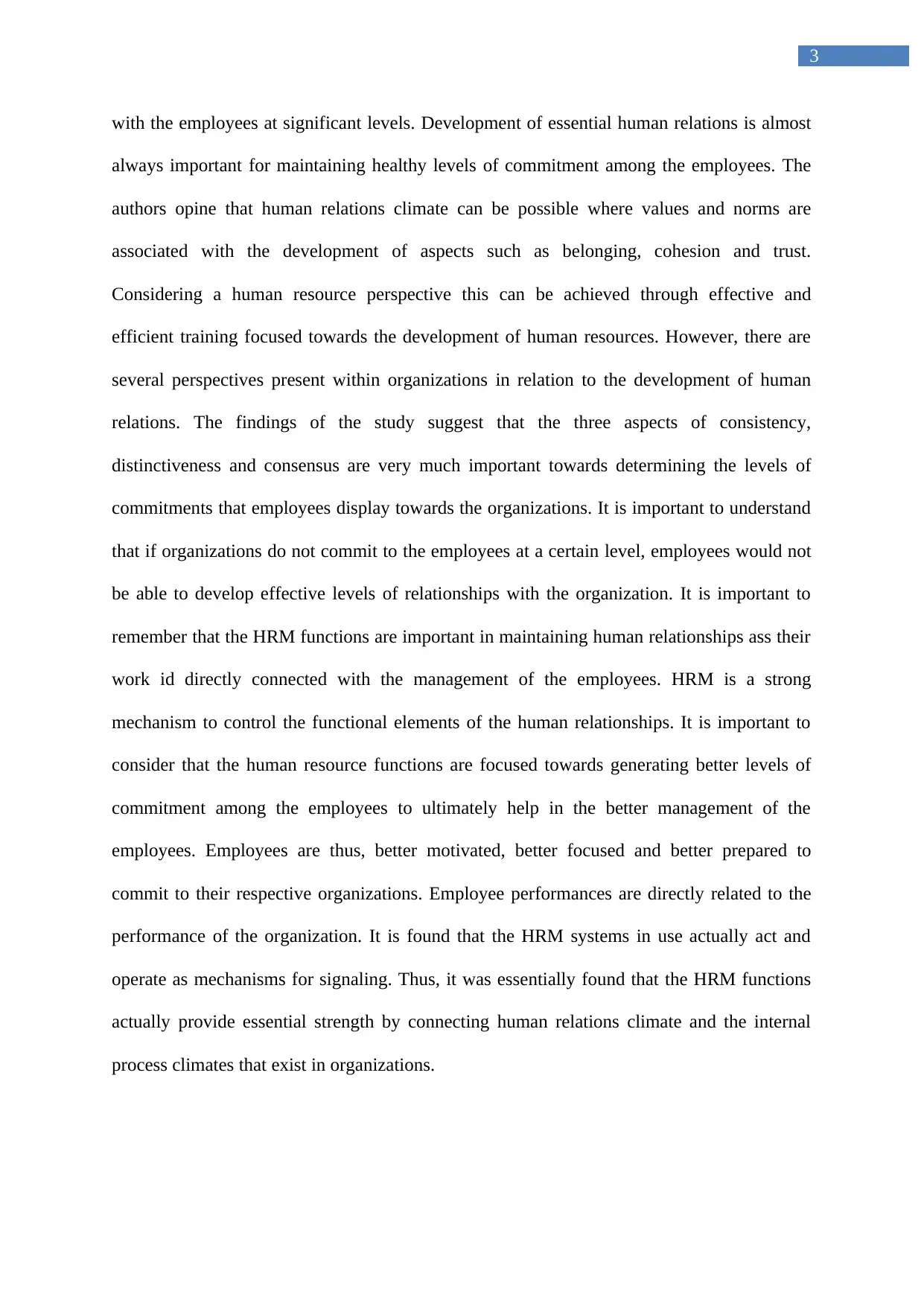
3
with the employees at significant levels. Development of essential human relations is almost
always important for maintaining healthy levels of commitment among the employees. The
authors opine that human relations climate can be possible where values and norms are
associated with the development of aspects such as belonging, cohesion and trust.
Considering a human resource perspective this can be achieved through effective and
efficient training focused towards the development of human resources. However, there are
several perspectives present within organizations in relation to the development of human
relations. The findings of the study suggest that the three aspects of consistency,
distinctiveness and consensus are very much important towards determining the levels of
commitments that employees display towards the organizations. It is important to understand
that if organizations do not commit to the employees at a certain level, employees would not
be able to develop effective levels of relationships with the organization. It is important to
remember that the HRM functions are important in maintaining human relationships ass their
work id directly connected with the management of the employees. HRM is a strong
mechanism to control the functional elements of the human relationships. It is important to
consider that the human resource functions are focused towards generating better levels of
commitment among the employees to ultimately help in the better management of the
employees. Employees are thus, better motivated, better focused and better prepared to
commit to their respective organizations. Employee performances are directly related to the
performance of the organization. It is found that the HRM systems in use actually act and
operate as mechanisms for signaling. Thus, it was essentially found that the HRM functions
actually provide essential strength by connecting human relations climate and the internal
process climates that exist in organizations.
with the employees at significant levels. Development of essential human relations is almost
always important for maintaining healthy levels of commitment among the employees. The
authors opine that human relations climate can be possible where values and norms are
associated with the development of aspects such as belonging, cohesion and trust.
Considering a human resource perspective this can be achieved through effective and
efficient training focused towards the development of human resources. However, there are
several perspectives present within organizations in relation to the development of human
relations. The findings of the study suggest that the three aspects of consistency,
distinctiveness and consensus are very much important towards determining the levels of
commitments that employees display towards the organizations. It is important to understand
that if organizations do not commit to the employees at a certain level, employees would not
be able to develop effective levels of relationships with the organization. It is important to
remember that the HRM functions are important in maintaining human relationships ass their
work id directly connected with the management of the employees. HRM is a strong
mechanism to control the functional elements of the human relationships. It is important to
consider that the human resource functions are focused towards generating better levels of
commitment among the employees to ultimately help in the better management of the
employees. Employees are thus, better motivated, better focused and better prepared to
commit to their respective organizations. Employee performances are directly related to the
performance of the organization. It is found that the HRM systems in use actually act and
operate as mechanisms for signaling. Thus, it was essentially found that the HRM functions
actually provide essential strength by connecting human relations climate and the internal
process climates that exist in organizations.
Secure Best Marks with AI Grader
Need help grading? Try our AI Grader for instant feedback on your assignments.
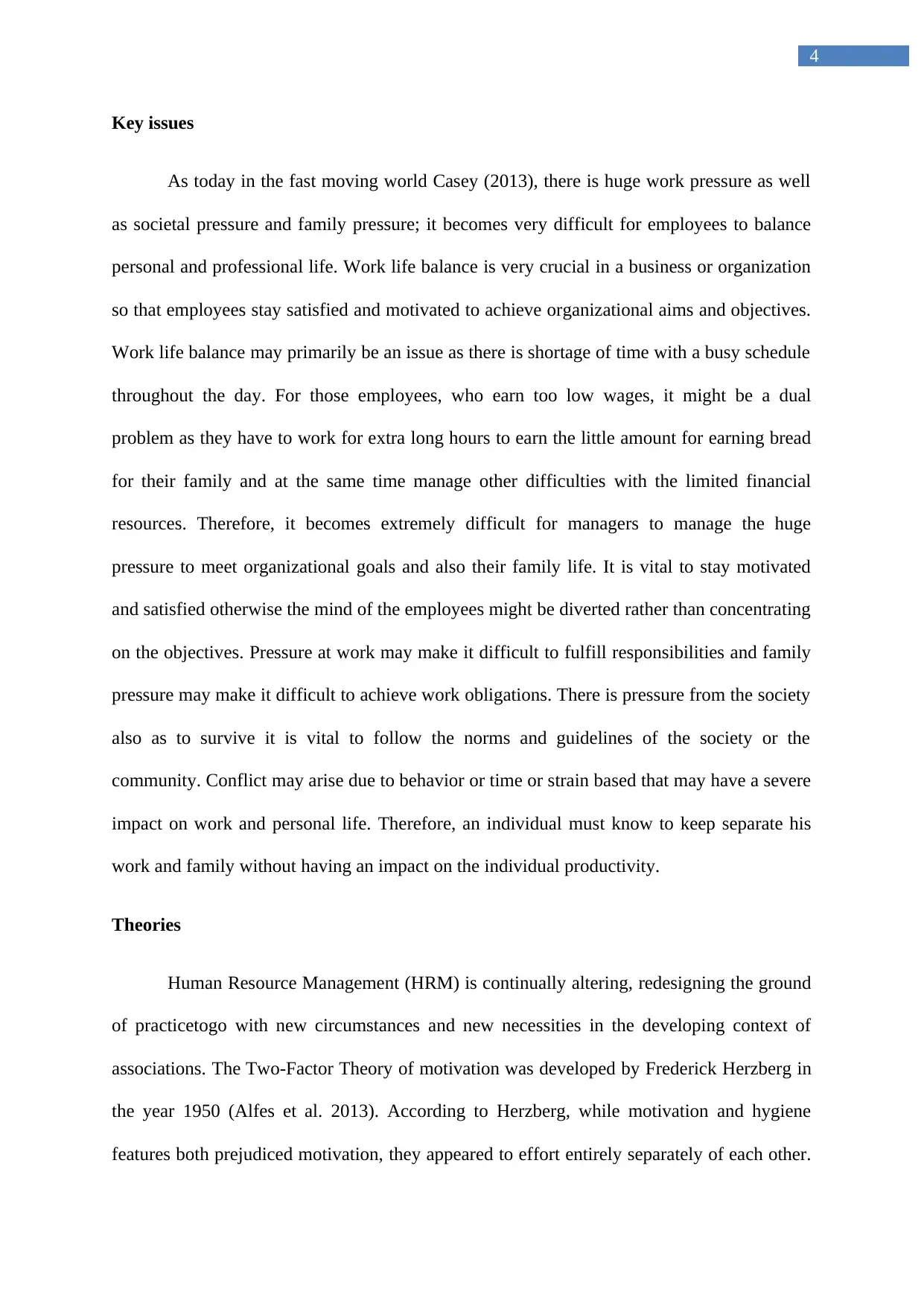
4
Key issues
As today in the fast moving world Casey (2013), there is huge work pressure as well
as societal pressure and family pressure; it becomes very difficult for employees to balance
personal and professional life. Work life balance is very crucial in a business or organization
so that employees stay satisfied and motivated to achieve organizational aims and objectives.
Work life balance may primarily be an issue as there is shortage of time with a busy schedule
throughout the day. For those employees, who earn too low wages, it might be a dual
problem as they have to work for extra long hours to earn the little amount for earning bread
for their family and at the same time manage other difficulties with the limited financial
resources. Therefore, it becomes extremely difficult for managers to manage the huge
pressure to meet organizational goals and also their family life. It is vital to stay motivated
and satisfied otherwise the mind of the employees might be diverted rather than concentrating
on the objectives. Pressure at work may make it difficult to fulfill responsibilities and family
pressure may make it difficult to achieve work obligations. There is pressure from the society
also as to survive it is vital to follow the norms and guidelines of the society or the
community. Conflict may arise due to behavior or time or strain based that may have a severe
impact on work and personal life. Therefore, an individual must know to keep separate his
work and family without having an impact on the individual productivity.
Theories
Human Resource Management (HRM) is continually altering, redesigning the ground
of practicetogo with new circumstances and new necessities in the developing context of
associations. The Two-Factor Theory of motivation was developed by Frederick Herzberg in
the year 1950 (Alfes et al. 2013). According to Herzberg, while motivation and hygiene
features both prejudiced motivation, they appeared to effort entirely separately of each other.
Key issues
As today in the fast moving world Casey (2013), there is huge work pressure as well
as societal pressure and family pressure; it becomes very difficult for employees to balance
personal and professional life. Work life balance is very crucial in a business or organization
so that employees stay satisfied and motivated to achieve organizational aims and objectives.
Work life balance may primarily be an issue as there is shortage of time with a busy schedule
throughout the day. For those employees, who earn too low wages, it might be a dual
problem as they have to work for extra long hours to earn the little amount for earning bread
for their family and at the same time manage other difficulties with the limited financial
resources. Therefore, it becomes extremely difficult for managers to manage the huge
pressure to meet organizational goals and also their family life. It is vital to stay motivated
and satisfied otherwise the mind of the employees might be diverted rather than concentrating
on the objectives. Pressure at work may make it difficult to fulfill responsibilities and family
pressure may make it difficult to achieve work obligations. There is pressure from the society
also as to survive it is vital to follow the norms and guidelines of the society or the
community. Conflict may arise due to behavior or time or strain based that may have a severe
impact on work and personal life. Therefore, an individual must know to keep separate his
work and family without having an impact on the individual productivity.
Theories
Human Resource Management (HRM) is continually altering, redesigning the ground
of practicetogo with new circumstances and new necessities in the developing context of
associations. The Two-Factor Theory of motivation was developed by Frederick Herzberg in
the year 1950 (Alfes et al. 2013). According to Herzberg, while motivation and hygiene
features both prejudiced motivation, they appeared to effort entirely separately of each other.
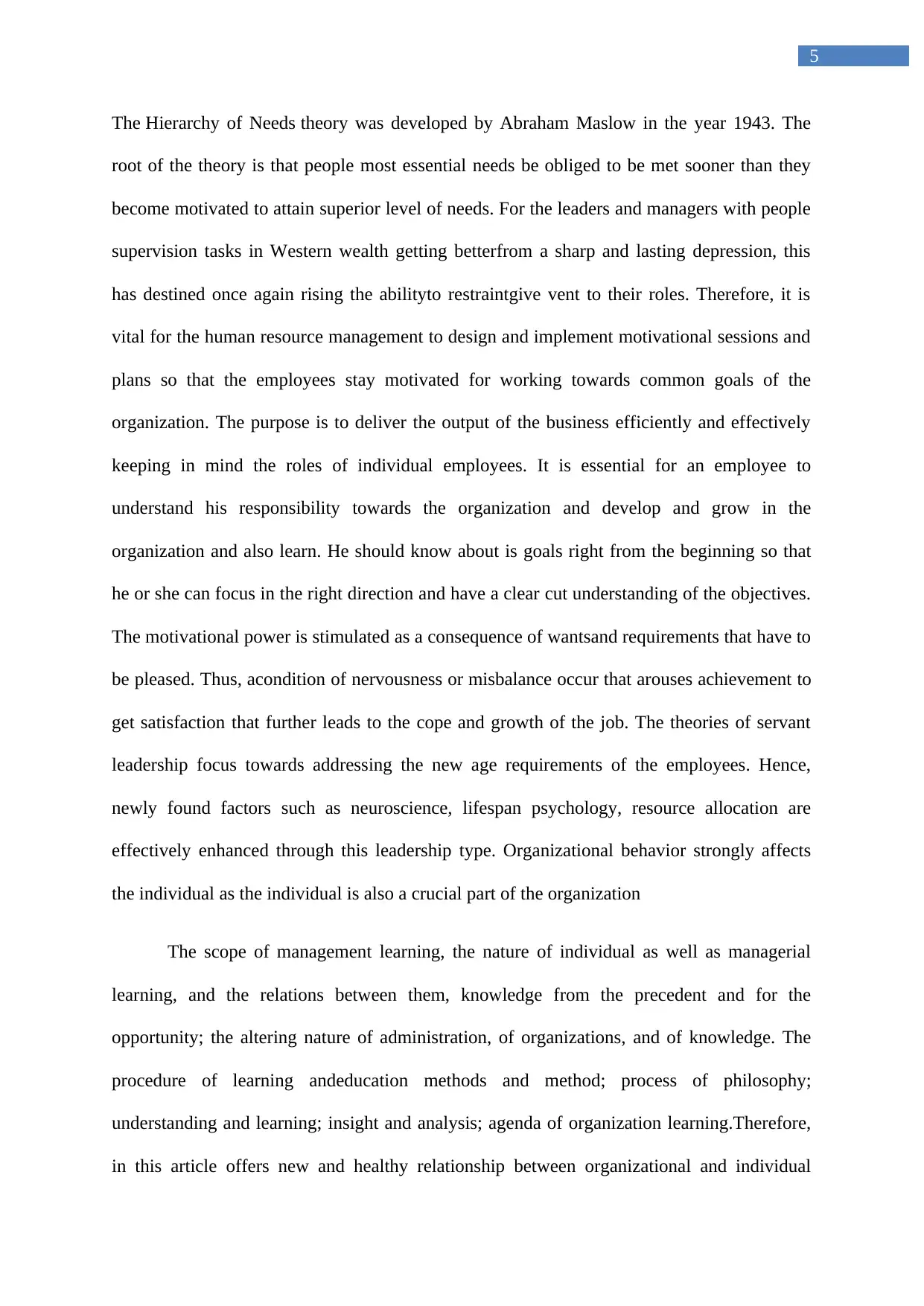
5
The Hierarchy of Needs theory was developed by Abraham Maslow in the year 1943. The
root of the theory is that people most essential needs be obliged to be met sooner than they
become motivated to attain superior level of needs. For the leaders and managers with people
supervision tasks in Western wealth getting betterfrom a sharp and lasting depression, this
has destined once again rising the abilityto restraintgive vent to their roles. Therefore, it is
vital for the human resource management to design and implement motivational sessions and
plans so that the employees stay motivated for working towards common goals of the
organization. The purpose is to deliver the output of the business efficiently and effectively
keeping in mind the roles of individual employees. It is essential for an employee to
understand his responsibility towards the organization and develop and grow in the
organization and also learn. He should know about is goals right from the beginning so that
he or she can focus in the right direction and have a clear cut understanding of the objectives.
The motivational power is stimulated as a consequence of wantsand requirements that have to
be pleased. Thus, acondition of nervousness or misbalance occur that arouses achievement to
get satisfaction that further leads to the cope and growth of the job. The theories of servant
leadership focus towards addressing the new age requirements of the employees. Hence,
newly found factors such as neuroscience, lifespan psychology, resource allocation are
effectively enhanced through this leadership type. Organizational behavior strongly affects
the individual as the individual is also a crucial part of the organization
The scope of management learning, the nature of individual as well as managerial
learning, and the relations between them, knowledge from the precedent and for the
opportunity; the altering nature of administration, of organizations, and of knowledge. The
procedure of learning andeducation methods and method; process of philosophy;
understanding and learning; insight and analysis; agenda of organization learning.Therefore,
in this article offers new and healthy relationship between organizational and individual
The Hierarchy of Needs theory was developed by Abraham Maslow in the year 1943. The
root of the theory is that people most essential needs be obliged to be met sooner than they
become motivated to attain superior level of needs. For the leaders and managers with people
supervision tasks in Western wealth getting betterfrom a sharp and lasting depression, this
has destined once again rising the abilityto restraintgive vent to their roles. Therefore, it is
vital for the human resource management to design and implement motivational sessions and
plans so that the employees stay motivated for working towards common goals of the
organization. The purpose is to deliver the output of the business efficiently and effectively
keeping in mind the roles of individual employees. It is essential for an employee to
understand his responsibility towards the organization and develop and grow in the
organization and also learn. He should know about is goals right from the beginning so that
he or she can focus in the right direction and have a clear cut understanding of the objectives.
The motivational power is stimulated as a consequence of wantsand requirements that have to
be pleased. Thus, acondition of nervousness or misbalance occur that arouses achievement to
get satisfaction that further leads to the cope and growth of the job. The theories of servant
leadership focus towards addressing the new age requirements of the employees. Hence,
newly found factors such as neuroscience, lifespan psychology, resource allocation are
effectively enhanced through this leadership type. Organizational behavior strongly affects
the individual as the individual is also a crucial part of the organization
The scope of management learning, the nature of individual as well as managerial
learning, and the relations between them, knowledge from the precedent and for the
opportunity; the altering nature of administration, of organizations, and of knowledge. The
procedure of learning andeducation methods and method; process of philosophy;
understanding and learning; insight and analysis; agenda of organization learning.Therefore,
in this article offers new and healthy relationship between organizational and individual
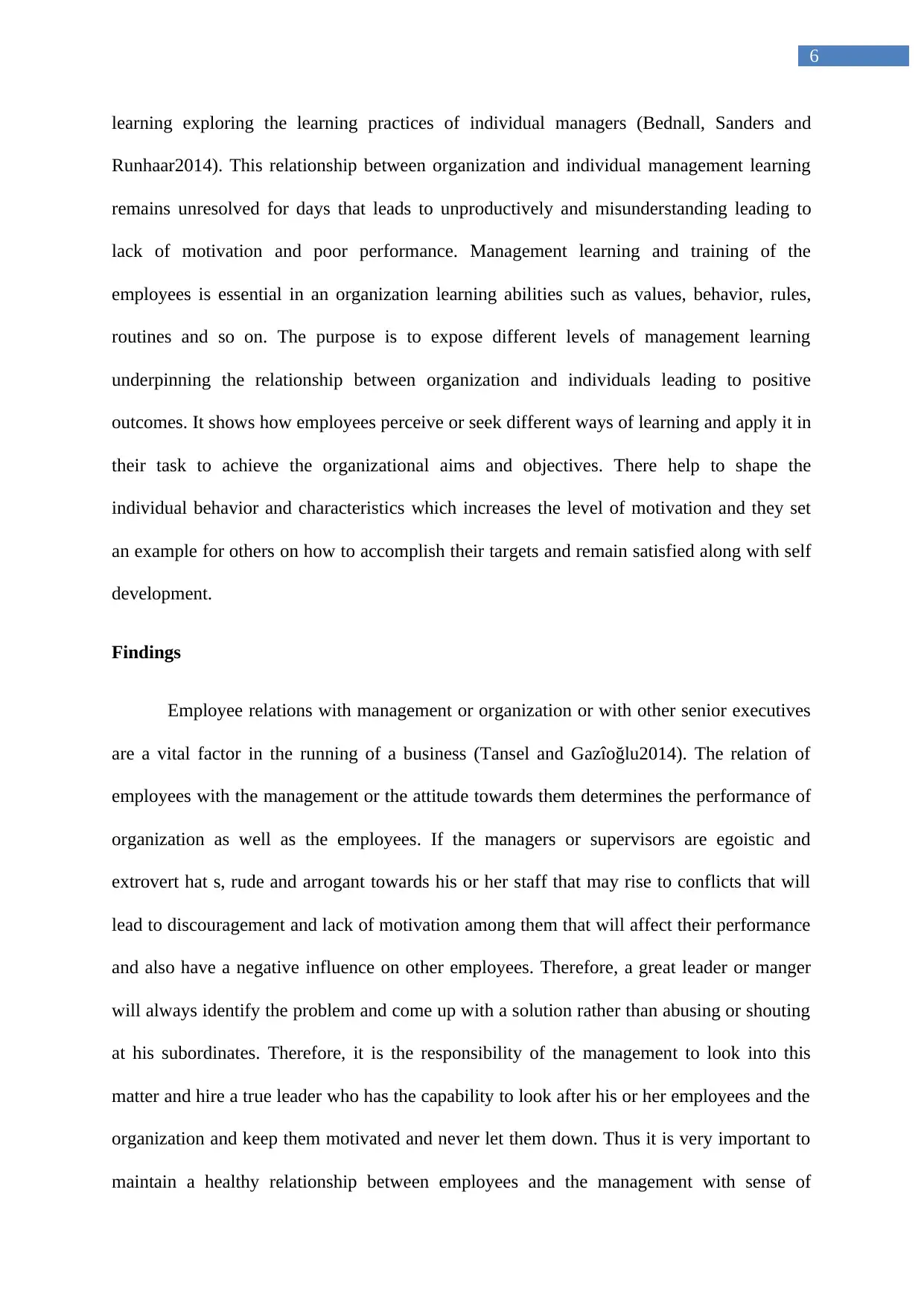
6
learning exploring the learning practices of individual managers (Bednall, Sanders and
Runhaar2014). This relationship between organization and individual management learning
remains unresolved for days that leads to unproductively and misunderstanding leading to
lack of motivation and poor performance. Management learning and training of the
employees is essential in an organization learning abilities such as values, behavior, rules,
routines and so on. The purpose is to expose different levels of management learning
underpinning the relationship between organization and individuals leading to positive
outcomes. It shows how employees perceive or seek different ways of learning and apply it in
their task to achieve the organizational aims and objectives. There help to shape the
individual behavior and characteristics which increases the level of motivation and they set
an example for others on how to accomplish their targets and remain satisfied along with self
development.
Findings
Employee relations with management or organization or with other senior executives
are a vital factor in the running of a business (Tansel and Gazîoğlu2014). The relation of
employees with the management or the attitude towards them determines the performance of
organization as well as the employees. If the managers or supervisors are egoistic and
extrovert hat s, rude and arrogant towards his or her staff that may rise to conflicts that will
lead to discouragement and lack of motivation among them that will affect their performance
and also have a negative influence on other employees. Therefore, a great leader or manger
will always identify the problem and come up with a solution rather than abusing or shouting
at his subordinates. Therefore, it is the responsibility of the management to look into this
matter and hire a true leader who has the capability to look after his or her employees and the
organization and keep them motivated and never let them down. Thus it is very important to
maintain a healthy relationship between employees and the management with sense of
learning exploring the learning practices of individual managers (Bednall, Sanders and
Runhaar2014). This relationship between organization and individual management learning
remains unresolved for days that leads to unproductively and misunderstanding leading to
lack of motivation and poor performance. Management learning and training of the
employees is essential in an organization learning abilities such as values, behavior, rules,
routines and so on. The purpose is to expose different levels of management learning
underpinning the relationship between organization and individuals leading to positive
outcomes. It shows how employees perceive or seek different ways of learning and apply it in
their task to achieve the organizational aims and objectives. There help to shape the
individual behavior and characteristics which increases the level of motivation and they set
an example for others on how to accomplish their targets and remain satisfied along with self
development.
Findings
Employee relations with management or organization or with other senior executives
are a vital factor in the running of a business (Tansel and Gazîoğlu2014). The relation of
employees with the management or the attitude towards them determines the performance of
organization as well as the employees. If the managers or supervisors are egoistic and
extrovert hat s, rude and arrogant towards his or her staff that may rise to conflicts that will
lead to discouragement and lack of motivation among them that will affect their performance
and also have a negative influence on other employees. Therefore, a great leader or manger
will always identify the problem and come up with a solution rather than abusing or shouting
at his subordinates. Therefore, it is the responsibility of the management to look into this
matter and hire a true leader who has the capability to look after his or her employees and the
organization and keep them motivated and never let them down. Thus it is very important to
maintain a healthy relationship between employees and the management with sense of
Paraphrase This Document
Need a fresh take? Get an instant paraphrase of this document with our AI Paraphraser
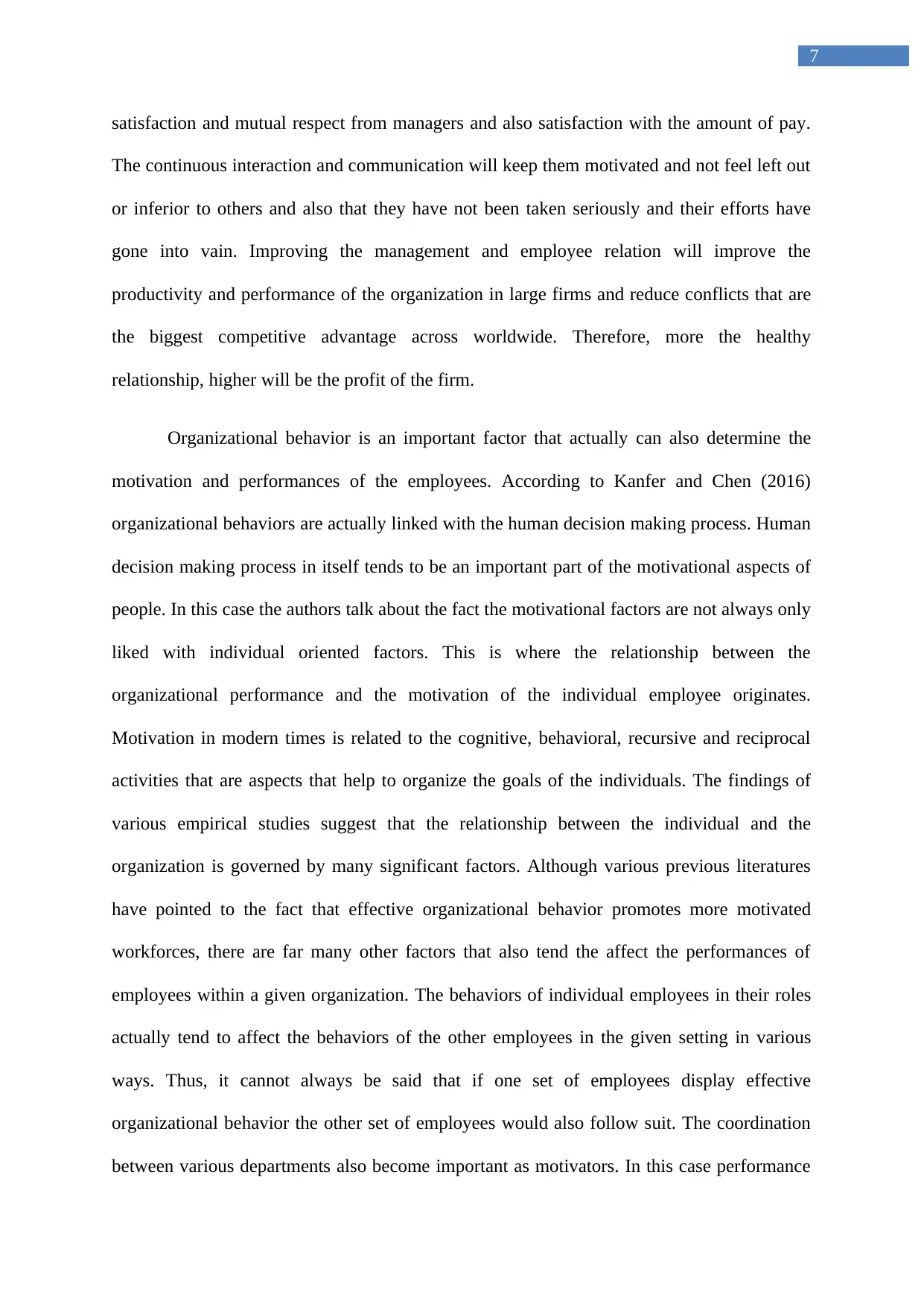
7
satisfaction and mutual respect from managers and also satisfaction with the amount of pay.
The continuous interaction and communication will keep them motivated and not feel left out
or inferior to others and also that they have not been taken seriously and their efforts have
gone into vain. Improving the management and employee relation will improve the
productivity and performance of the organization in large firms and reduce conflicts that are
the biggest competitive advantage across worldwide. Therefore, more the healthy
relationship, higher will be the profit of the firm.
Organizational behavior is an important factor that actually can also determine the
motivation and performances of the employees. According to Kanfer and Chen (2016)
organizational behaviors are actually linked with the human decision making process. Human
decision making process in itself tends to be an important part of the motivational aspects of
people. In this case the authors talk about the fact the motivational factors are not always only
liked with individual oriented factors. This is where the relationship between the
organizational performance and the motivation of the individual employee originates.
Motivation in modern times is related to the cognitive, behavioral, recursive and reciprocal
activities that are aspects that help to organize the goals of the individuals. The findings of
various empirical studies suggest that the relationship between the individual and the
organization is governed by many significant factors. Although various previous literatures
have pointed to the fact that effective organizational behavior promotes more motivated
workforces, there are far many other factors that also tend the affect the performances of
employees within a given organization. The behaviors of individual employees in their roles
actually tend to affect the behaviors of the other employees in the given setting in various
ways. Thus, it cannot always be said that if one set of employees display effective
organizational behavior the other set of employees would also follow suit. The coordination
between various departments also become important as motivators. In this case performance
satisfaction and mutual respect from managers and also satisfaction with the amount of pay.
The continuous interaction and communication will keep them motivated and not feel left out
or inferior to others and also that they have not been taken seriously and their efforts have
gone into vain. Improving the management and employee relation will improve the
productivity and performance of the organization in large firms and reduce conflicts that are
the biggest competitive advantage across worldwide. Therefore, more the healthy
relationship, higher will be the profit of the firm.
Organizational behavior is an important factor that actually can also determine the
motivation and performances of the employees. According to Kanfer and Chen (2016)
organizational behaviors are actually linked with the human decision making process. Human
decision making process in itself tends to be an important part of the motivational aspects of
people. In this case the authors talk about the fact the motivational factors are not always only
liked with individual oriented factors. This is where the relationship between the
organizational performance and the motivation of the individual employee originates.
Motivation in modern times is related to the cognitive, behavioral, recursive and reciprocal
activities that are aspects that help to organize the goals of the individuals. The findings of
various empirical studies suggest that the relationship between the individual and the
organization is governed by many significant factors. Although various previous literatures
have pointed to the fact that effective organizational behavior promotes more motivated
workforces, there are far many other factors that also tend the affect the performances of
employees within a given organization. The behaviors of individual employees in their roles
actually tend to affect the behaviors of the other employees in the given setting in various
ways. Thus, it cannot always be said that if one set of employees display effective
organizational behavior the other set of employees would also follow suit. The coordination
between various departments also become important as motivators. In this case performance
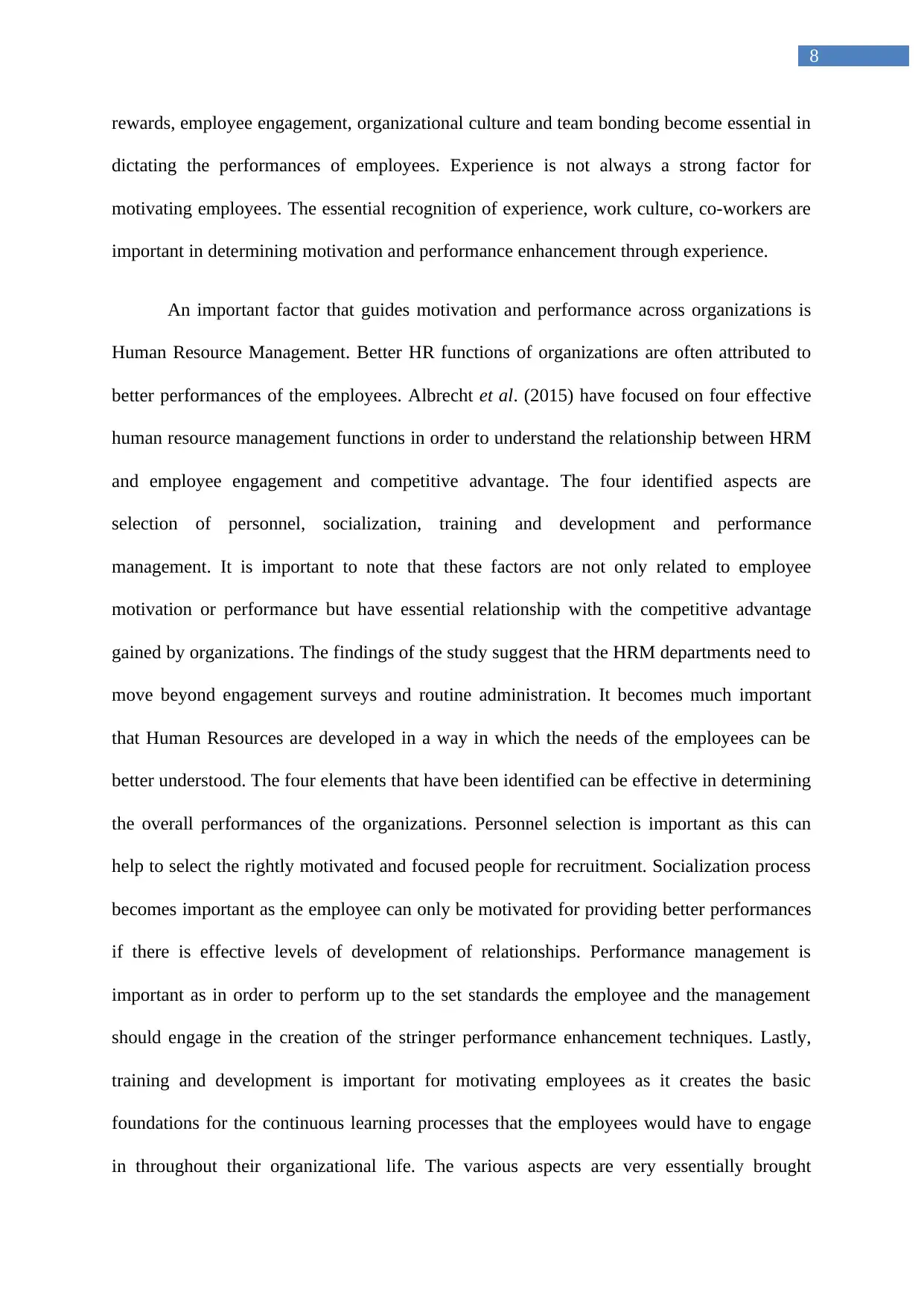
8
rewards, employee engagement, organizational culture and team bonding become essential in
dictating the performances of employees. Experience is not always a strong factor for
motivating employees. The essential recognition of experience, work culture, co-workers are
important in determining motivation and performance enhancement through experience.
An important factor that guides motivation and performance across organizations is
Human Resource Management. Better HR functions of organizations are often attributed to
better performances of the employees. Albrecht et al. (2015) have focused on four effective
human resource management functions in order to understand the relationship between HRM
and employee engagement and competitive advantage. The four identified aspects are
selection of personnel, socialization, training and development and performance
management. It is important to note that these factors are not only related to employee
motivation or performance but have essential relationship with the competitive advantage
gained by organizations. The findings of the study suggest that the HRM departments need to
move beyond engagement surveys and routine administration. It becomes much important
that Human Resources are developed in a way in which the needs of the employees can be
better understood. The four elements that have been identified can be effective in determining
the overall performances of the organizations. Personnel selection is important as this can
help to select the rightly motivated and focused people for recruitment. Socialization process
becomes important as the employee can only be motivated for providing better performances
if there is effective levels of development of relationships. Performance management is
important as in order to perform up to the set standards the employee and the management
should engage in the creation of the stringer performance enhancement techniques. Lastly,
training and development is important for motivating employees as it creates the basic
foundations for the continuous learning processes that the employees would have to engage
in throughout their organizational life. The various aspects are very essentially brought
rewards, employee engagement, organizational culture and team bonding become essential in
dictating the performances of employees. Experience is not always a strong factor for
motivating employees. The essential recognition of experience, work culture, co-workers are
important in determining motivation and performance enhancement through experience.
An important factor that guides motivation and performance across organizations is
Human Resource Management. Better HR functions of organizations are often attributed to
better performances of the employees. Albrecht et al. (2015) have focused on four effective
human resource management functions in order to understand the relationship between HRM
and employee engagement and competitive advantage. The four identified aspects are
selection of personnel, socialization, training and development and performance
management. It is important to note that these factors are not only related to employee
motivation or performance but have essential relationship with the competitive advantage
gained by organizations. The findings of the study suggest that the HRM departments need to
move beyond engagement surveys and routine administration. It becomes much important
that Human Resources are developed in a way in which the needs of the employees can be
better understood. The four elements that have been identified can be effective in determining
the overall performances of the organizations. Personnel selection is important as this can
help to select the rightly motivated and focused people for recruitment. Socialization process
becomes important as the employee can only be motivated for providing better performances
if there is effective levels of development of relationships. Performance management is
important as in order to perform up to the set standards the employee and the management
should engage in the creation of the stringer performance enhancement techniques. Lastly,
training and development is important for motivating employees as it creates the basic
foundations for the continuous learning processes that the employees would have to engage
in throughout their organizational life. The various aspects are very essentially brought
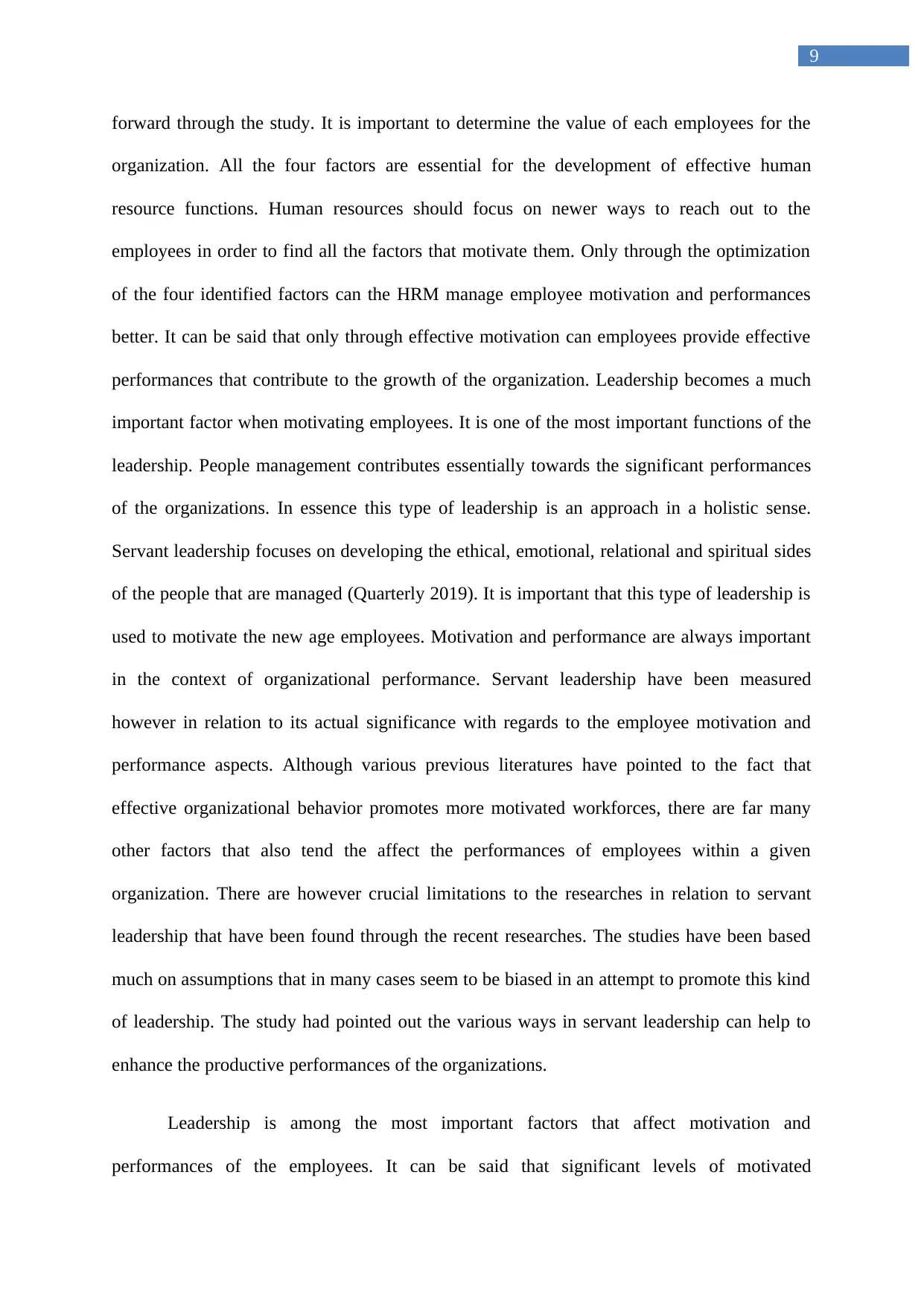
9
forward through the study. It is important to determine the value of each employees for the
organization. All the four factors are essential for the development of effective human
resource functions. Human resources should focus on newer ways to reach out to the
employees in order to find all the factors that motivate them. Only through the optimization
of the four identified factors can the HRM manage employee motivation and performances
better. It can be said that only through effective motivation can employees provide effective
performances that contribute to the growth of the organization. Leadership becomes a much
important factor when motivating employees. It is one of the most important functions of the
leadership. People management contributes essentially towards the significant performances
of the organizations. In essence this type of leadership is an approach in a holistic sense.
Servant leadership focuses on developing the ethical, emotional, relational and spiritual sides
of the people that are managed (Quarterly 2019). It is important that this type of leadership is
used to motivate the new age employees. Motivation and performance are always important
in the context of organizational performance. Servant leadership have been measured
however in relation to its actual significance with regards to the employee motivation and
performance aspects. Although various previous literatures have pointed to the fact that
effective organizational behavior promotes more motivated workforces, there are far many
other factors that also tend the affect the performances of employees within a given
organization. There are however crucial limitations to the researches in relation to servant
leadership that have been found through the recent researches. The studies have been based
much on assumptions that in many cases seem to be biased in an attempt to promote this kind
of leadership. The study had pointed out the various ways in servant leadership can help to
enhance the productive performances of the organizations.
Leadership is among the most important factors that affect motivation and
performances of the employees. It can be said that significant levels of motivated
forward through the study. It is important to determine the value of each employees for the
organization. All the four factors are essential for the development of effective human
resource functions. Human resources should focus on newer ways to reach out to the
employees in order to find all the factors that motivate them. Only through the optimization
of the four identified factors can the HRM manage employee motivation and performances
better. It can be said that only through effective motivation can employees provide effective
performances that contribute to the growth of the organization. Leadership becomes a much
important factor when motivating employees. It is one of the most important functions of the
leadership. People management contributes essentially towards the significant performances
of the organizations. In essence this type of leadership is an approach in a holistic sense.
Servant leadership focuses on developing the ethical, emotional, relational and spiritual sides
of the people that are managed (Quarterly 2019). It is important that this type of leadership is
used to motivate the new age employees. Motivation and performance are always important
in the context of organizational performance. Servant leadership have been measured
however in relation to its actual significance with regards to the employee motivation and
performance aspects. Although various previous literatures have pointed to the fact that
effective organizational behavior promotes more motivated workforces, there are far many
other factors that also tend the affect the performances of employees within a given
organization. There are however crucial limitations to the researches in relation to servant
leadership that have been found through the recent researches. The studies have been based
much on assumptions that in many cases seem to be biased in an attempt to promote this kind
of leadership. The study had pointed out the various ways in servant leadership can help to
enhance the productive performances of the organizations.
Leadership is among the most important factors that affect motivation and
performances of the employees. It can be said that significant levels of motivated
Secure Best Marks with AI Grader
Need help grading? Try our AI Grader for instant feedback on your assignments.
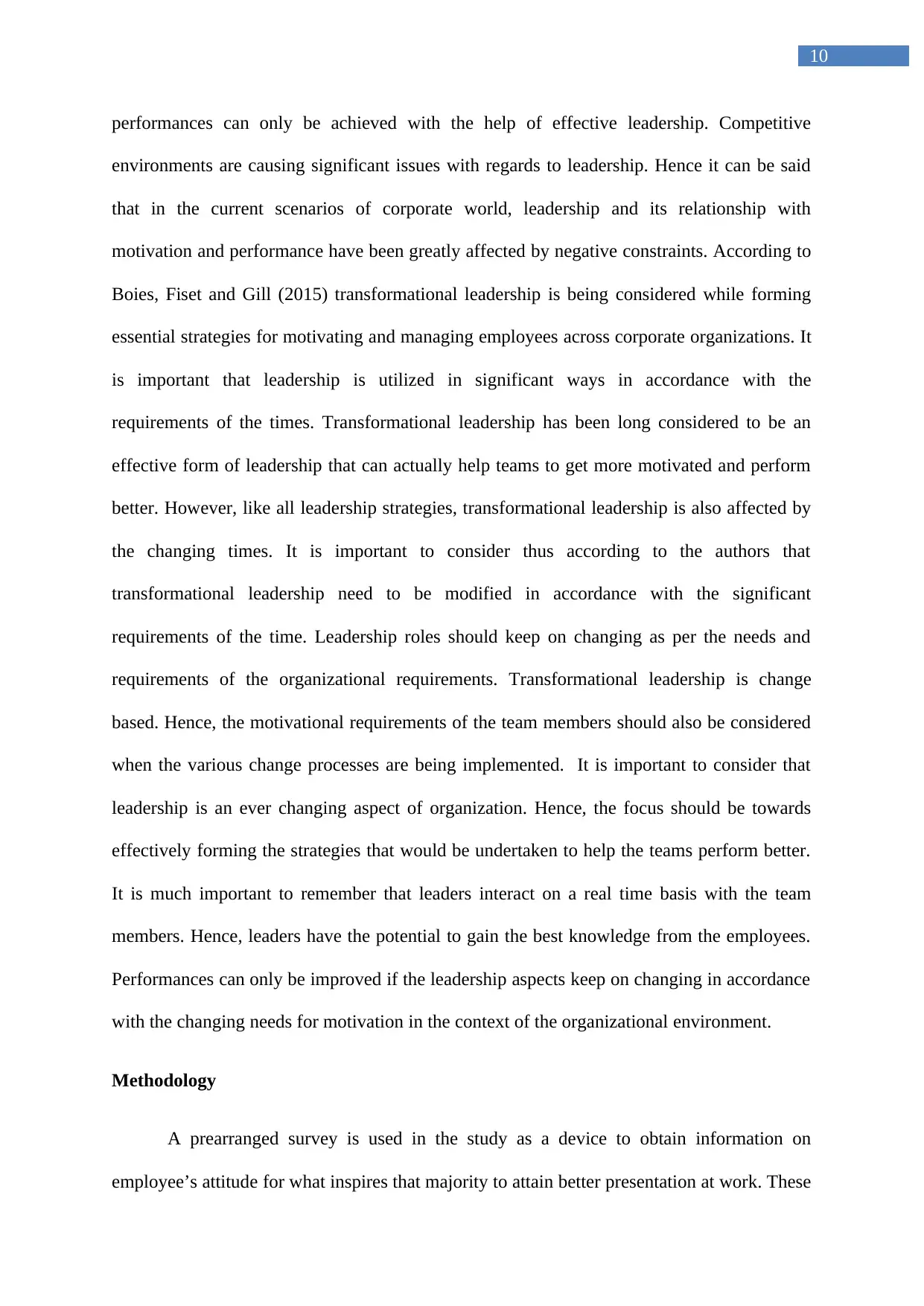
10
performances can only be achieved with the help of effective leadership. Competitive
environments are causing significant issues with regards to leadership. Hence it can be said
that in the current scenarios of corporate world, leadership and its relationship with
motivation and performance have been greatly affected by negative constraints. According to
Boies, Fiset and Gill (2015) transformational leadership is being considered while forming
essential strategies for motivating and managing employees across corporate organizations. It
is important that leadership is utilized in significant ways in accordance with the
requirements of the times. Transformational leadership has been long considered to be an
effective form of leadership that can actually help teams to get more motivated and perform
better. However, like all leadership strategies, transformational leadership is also affected by
the changing times. It is important to consider thus according to the authors that
transformational leadership need to be modified in accordance with the significant
requirements of the time. Leadership roles should keep on changing as per the needs and
requirements of the organizational requirements. Transformational leadership is change
based. Hence, the motivational requirements of the team members should also be considered
when the various change processes are being implemented. It is important to consider that
leadership is an ever changing aspect of organization. Hence, the focus should be towards
effectively forming the strategies that would be undertaken to help the teams perform better.
It is much important to remember that leaders interact on a real time basis with the team
members. Hence, leaders have the potential to gain the best knowledge from the employees.
Performances can only be improved if the leadership aspects keep on changing in accordance
with the changing needs for motivation in the context of the organizational environment.
Methodology
A prearranged survey is used in the study as a device to obtain information on
employee’s attitude for what inspires that majority to attain better presentation at work. These
performances can only be achieved with the help of effective leadership. Competitive
environments are causing significant issues with regards to leadership. Hence it can be said
that in the current scenarios of corporate world, leadership and its relationship with
motivation and performance have been greatly affected by negative constraints. According to
Boies, Fiset and Gill (2015) transformational leadership is being considered while forming
essential strategies for motivating and managing employees across corporate organizations. It
is important that leadership is utilized in significant ways in accordance with the
requirements of the times. Transformational leadership has been long considered to be an
effective form of leadership that can actually help teams to get more motivated and perform
better. However, like all leadership strategies, transformational leadership is also affected by
the changing times. It is important to consider thus according to the authors that
transformational leadership need to be modified in accordance with the significant
requirements of the time. Leadership roles should keep on changing as per the needs and
requirements of the organizational requirements. Transformational leadership is change
based. Hence, the motivational requirements of the team members should also be considered
when the various change processes are being implemented. It is important to consider that
leadership is an ever changing aspect of organization. Hence, the focus should be towards
effectively forming the strategies that would be undertaken to help the teams perform better.
It is much important to remember that leaders interact on a real time basis with the team
members. Hence, leaders have the potential to gain the best knowledge from the employees.
Performances can only be improved if the leadership aspects keep on changing in accordance
with the changing needs for motivation in the context of the organizational environment.
Methodology
A prearranged survey is used in the study as a device to obtain information on
employee’s attitude for what inspires that majority to attain better presentation at work. These
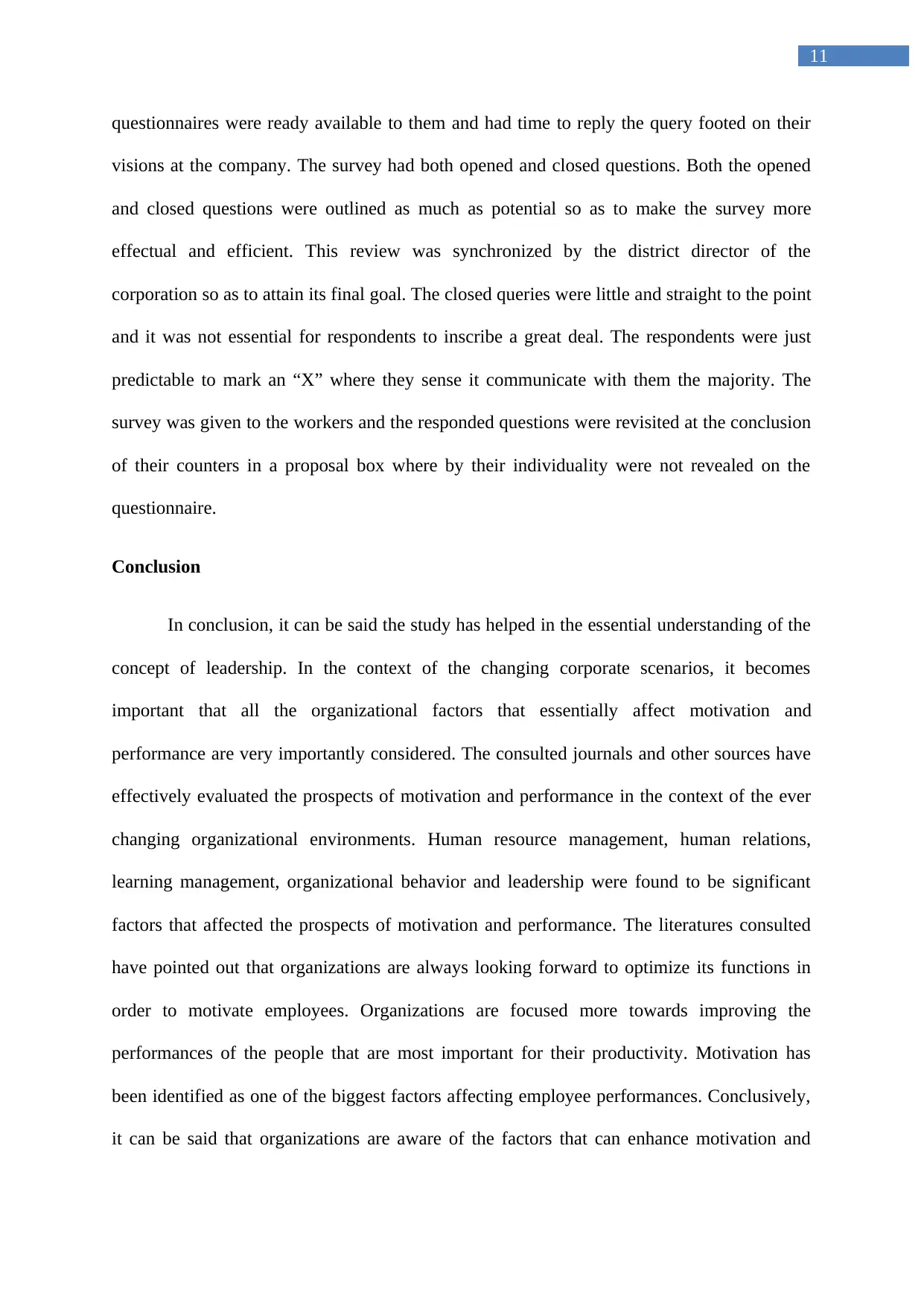
11
questionnaires were ready available to them and had time to reply the query footed on their
visions at the company. The survey had both opened and closed questions. Both the opened
and closed questions were outlined as much as potential so as to make the survey more
effectual and efficient. This review was synchronized by the district director of the
corporation so as to attain its final goal. The closed queries were little and straight to the point
and it was not essential for respondents to inscribe a great deal. The respondents were just
predictable to mark an “X” where they sense it communicate with them the majority. The
survey was given to the workers and the responded questions were revisited at the conclusion
of their counters in a proposal box where by their individuality were not revealed on the
questionnaire.
Conclusion
In conclusion, it can be said the study has helped in the essential understanding of the
concept of leadership. In the context of the changing corporate scenarios, it becomes
important that all the organizational factors that essentially affect motivation and
performance are very importantly considered. The consulted journals and other sources have
effectively evaluated the prospects of motivation and performance in the context of the ever
changing organizational environments. Human resource management, human relations,
learning management, organizational behavior and leadership were found to be significant
factors that affected the prospects of motivation and performance. The literatures consulted
have pointed out that organizations are always looking forward to optimize its functions in
order to motivate employees. Organizations are focused more towards improving the
performances of the people that are most important for their productivity. Motivation has
been identified as one of the biggest factors affecting employee performances. Conclusively,
it can be said that organizations are aware of the factors that can enhance motivation and
questionnaires were ready available to them and had time to reply the query footed on their
visions at the company. The survey had both opened and closed questions. Both the opened
and closed questions were outlined as much as potential so as to make the survey more
effectual and efficient. This review was synchronized by the district director of the
corporation so as to attain its final goal. The closed queries were little and straight to the point
and it was not essential for respondents to inscribe a great deal. The respondents were just
predictable to mark an “X” where they sense it communicate with them the majority. The
survey was given to the workers and the responded questions were revisited at the conclusion
of their counters in a proposal box where by their individuality were not revealed on the
questionnaire.
Conclusion
In conclusion, it can be said the study has helped in the essential understanding of the
concept of leadership. In the context of the changing corporate scenarios, it becomes
important that all the organizational factors that essentially affect motivation and
performance are very importantly considered. The consulted journals and other sources have
effectively evaluated the prospects of motivation and performance in the context of the ever
changing organizational environments. Human resource management, human relations,
learning management, organizational behavior and leadership were found to be significant
factors that affected the prospects of motivation and performance. The literatures consulted
have pointed out that organizations are always looking forward to optimize its functions in
order to motivate employees. Organizations are focused more towards improving the
performances of the people that are most important for their productivity. Motivation has
been identified as one of the biggest factors affecting employee performances. Conclusively,
it can be said that organizations are aware of the factors that can enhance motivation and
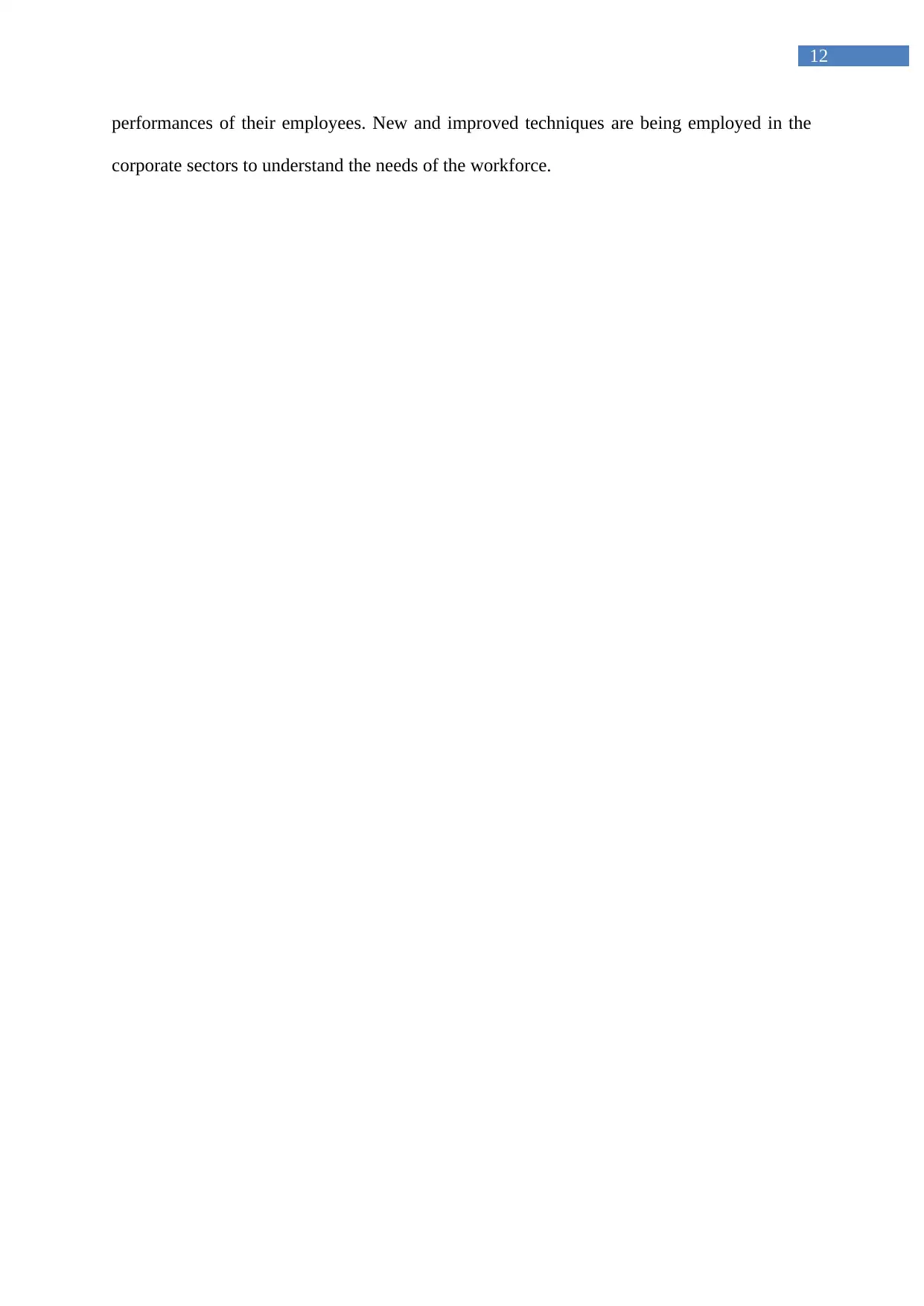
12
performances of their employees. New and improved techniques are being employed in the
corporate sectors to understand the needs of the workforce.
performances of their employees. New and improved techniques are being employed in the
corporate sectors to understand the needs of the workforce.
Paraphrase This Document
Need a fresh take? Get an instant paraphrase of this document with our AI Paraphraser
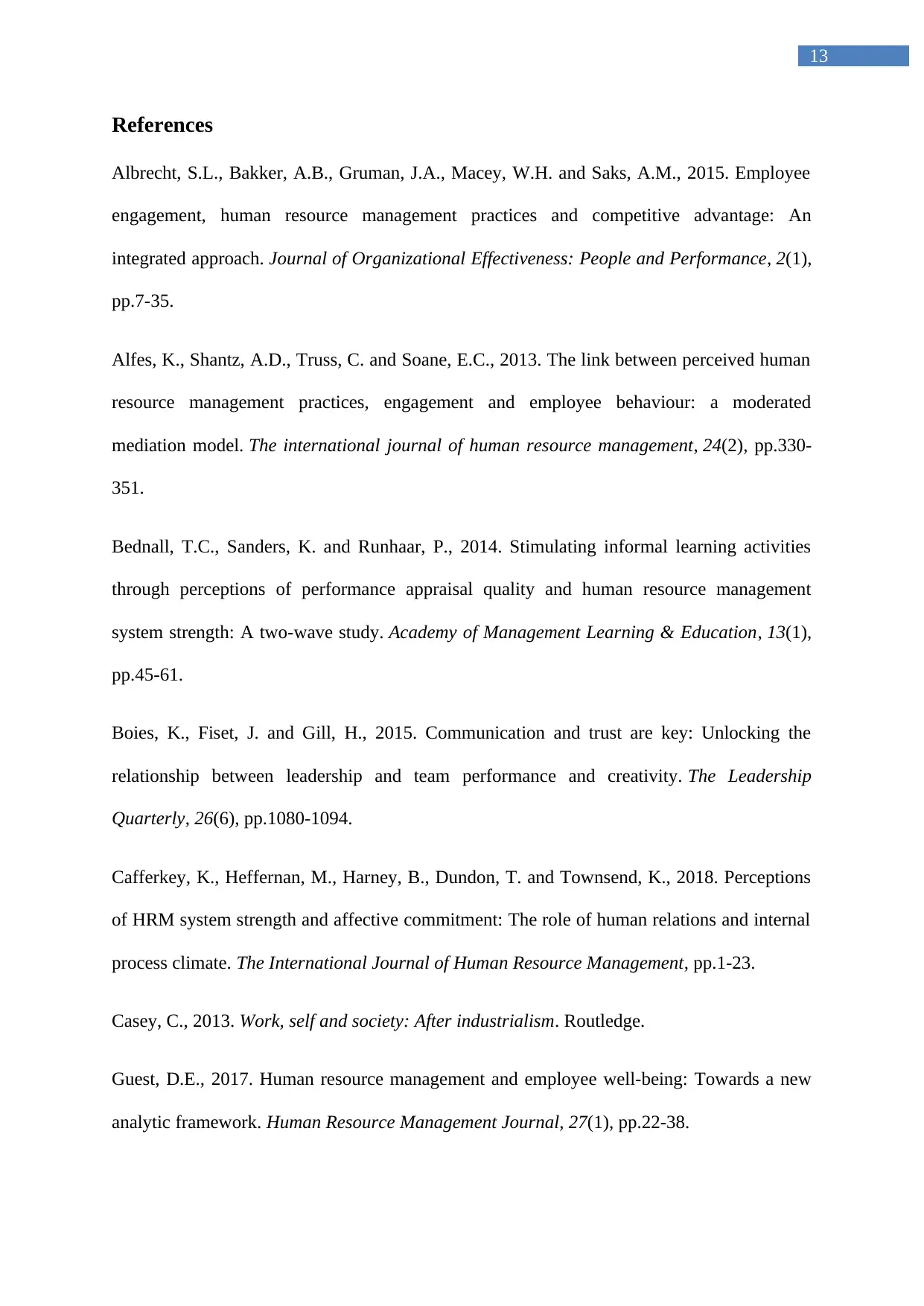
13
References
Albrecht, S.L., Bakker, A.B., Gruman, J.A., Macey, W.H. and Saks, A.M., 2015. Employee
engagement, human resource management practices and competitive advantage: An
integrated approach. Journal of Organizational Effectiveness: People and Performance, 2(1),
pp.7-35.
Alfes, K., Shantz, A.D., Truss, C. and Soane, E.C., 2013. The link between perceived human
resource management practices, engagement and employee behaviour: a moderated
mediation model. The international journal of human resource management, 24(2), pp.330-
351.
Bednall, T.C., Sanders, K. and Runhaar, P., 2014. Stimulating informal learning activities
through perceptions of performance appraisal quality and human resource management
system strength: A two-wave study. Academy of Management Learning & Education, 13(1),
pp.45-61.
Boies, K., Fiset, J. and Gill, H., 2015. Communication and trust are key: Unlocking the
relationship between leadership and team performance and creativity. The Leadership
Quarterly, 26(6), pp.1080-1094.
Cafferkey, K., Heffernan, M., Harney, B., Dundon, T. and Townsend, K., 2018. Perceptions
of HRM system strength and affective commitment: The role of human relations and internal
process climate. The International Journal of Human Resource Management, pp.1-23.
Casey, C., 2013. Work, self and society: After industrialism. Routledge.
Guest, D.E., 2017. Human resource management and employee well‐being: Towards a new
analytic framework. Human Resource Management Journal, 27(1), pp.22-38.
References
Albrecht, S.L., Bakker, A.B., Gruman, J.A., Macey, W.H. and Saks, A.M., 2015. Employee
engagement, human resource management practices and competitive advantage: An
integrated approach. Journal of Organizational Effectiveness: People and Performance, 2(1),
pp.7-35.
Alfes, K., Shantz, A.D., Truss, C. and Soane, E.C., 2013. The link between perceived human
resource management practices, engagement and employee behaviour: a moderated
mediation model. The international journal of human resource management, 24(2), pp.330-
351.
Bednall, T.C., Sanders, K. and Runhaar, P., 2014. Stimulating informal learning activities
through perceptions of performance appraisal quality and human resource management
system strength: A two-wave study. Academy of Management Learning & Education, 13(1),
pp.45-61.
Boies, K., Fiset, J. and Gill, H., 2015. Communication and trust are key: Unlocking the
relationship between leadership and team performance and creativity. The Leadership
Quarterly, 26(6), pp.1080-1094.
Cafferkey, K., Heffernan, M., Harney, B., Dundon, T. and Townsend, K., 2018. Perceptions
of HRM system strength and affective commitment: The role of human relations and internal
process climate. The International Journal of Human Resource Management, pp.1-23.
Casey, C., 2013. Work, self and society: After industrialism. Routledge.
Guest, D.E., 2017. Human resource management and employee well‐being: Towards a new
analytic framework. Human Resource Management Journal, 27(1), pp.22-38.
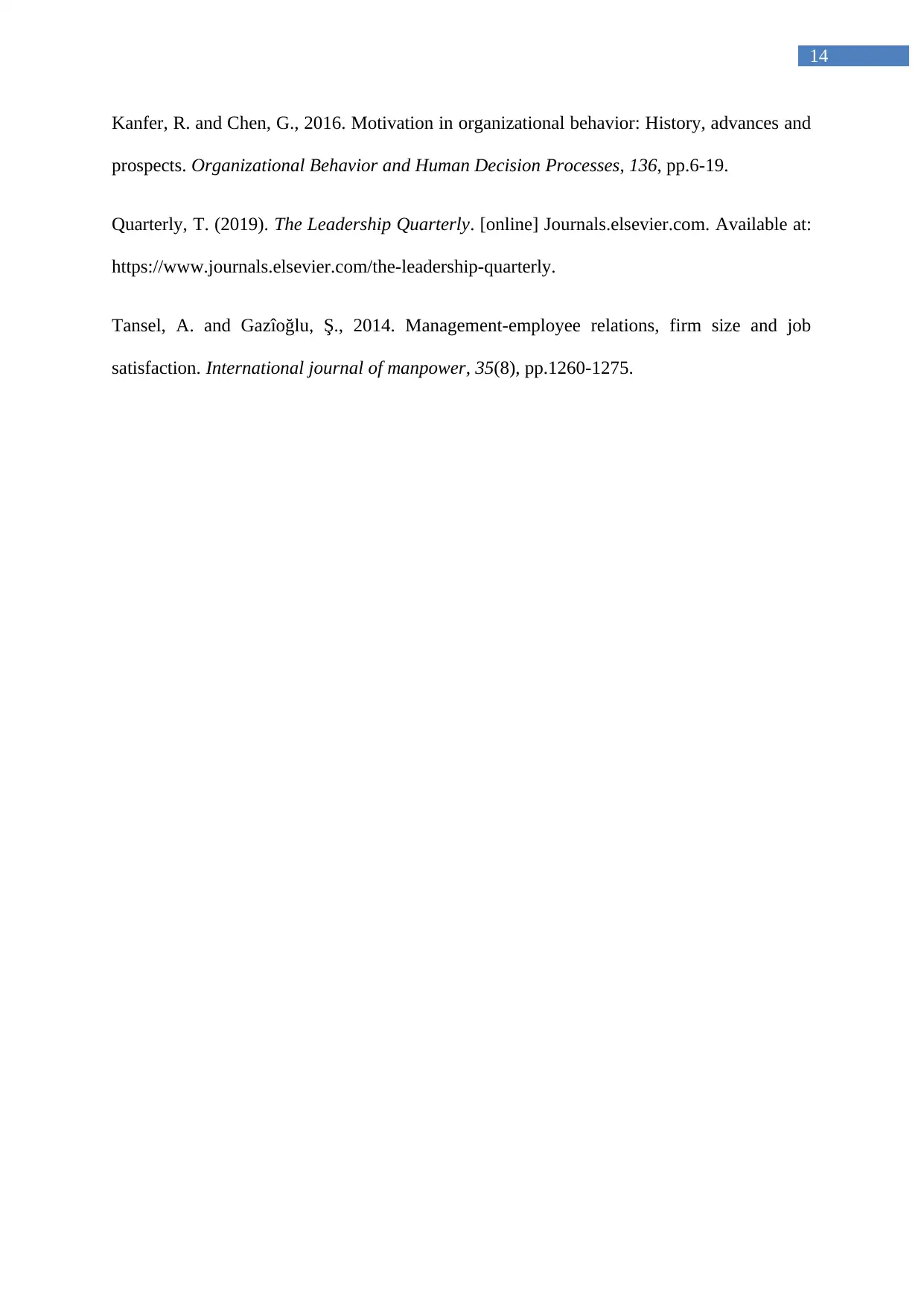
14
Kanfer, R. and Chen, G., 2016. Motivation in organizational behavior: History, advances and
prospects. Organizational Behavior and Human Decision Processes, 136, pp.6-19.
Quarterly, T. (2019). The Leadership Quarterly. [online] Journals.elsevier.com. Available at:
https://www.journals.elsevier.com/the-leadership-quarterly.
Tansel, A. and Gazîoğlu, Ş., 2014. Management-employee relations, firm size and job
satisfaction. International journal of manpower, 35(8), pp.1260-1275.
Kanfer, R. and Chen, G., 2016. Motivation in organizational behavior: History, advances and
prospects. Organizational Behavior and Human Decision Processes, 136, pp.6-19.
Quarterly, T. (2019). The Leadership Quarterly. [online] Journals.elsevier.com. Available at:
https://www.journals.elsevier.com/the-leadership-quarterly.
Tansel, A. and Gazîoğlu, Ş., 2014. Management-employee relations, firm size and job
satisfaction. International journal of manpower, 35(8), pp.1260-1275.
1 out of 15
Related Documents
Your All-in-One AI-Powered Toolkit for Academic Success.
+13062052269
info@desklib.com
Available 24*7 on WhatsApp / Email
![[object Object]](/_next/static/media/star-bottom.7253800d.svg)
Unlock your academic potential
© 2024 | Zucol Services PVT LTD | All rights reserved.




